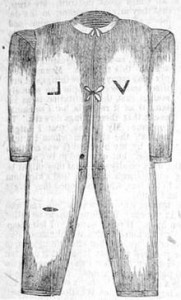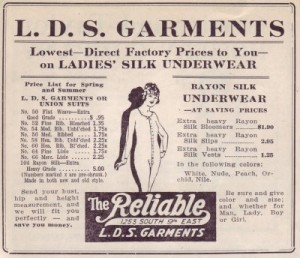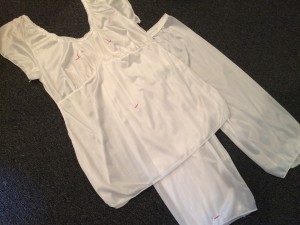Podcast: Play in new window | Download ()
Subscribe: Apple Podcasts | RSS
In 1912 some Mormon leaders doubted both the content and reliability of The King Follett Sermon. Mormon apostle George Albert Smith wrote:
“Sometime ago I received an invitation, mailed from the Liahona office, to contribute to a fund for the purpose of mailing copies of King Follet’s[sic] funeral sermon. At the time I was somewhat surprised, because I have thought that the report of that sermon might not be authentic and I have feared that it contained some things that might be contrary to the truth when I knew just what it was, so I did not reply to the letter. Not being very well, I did not feel like taking the matter up, and have learned since that some of the other brethren felt as I did and thought that greater publicity should not be given to that particular sermon.”
Full text here. Photos here and here.
Mormon apologist Blake Ostler writes,
“The First Presidency demonstrated its opposition to the idea of man’s necessary existence again in 1912 when it removed the King Follett discourse from [B.H.] Roberts’ Documentary History of the Church. Charles B. Penrose, in particular, doubted the authenticity and correctness of the reporting of the sermon.
Oh, what might have been 🙁
Podcast: Play in new window | Download (Duration: 14:00 — 12.8MB)
Subscribe: Apple Podcasts | RSS
Podcast: Play in new window | Download (Duration: 14:01 — 12.8MB)
Subscribe: Apple Podcasts | RSS
Podcast: Play in new window | Download (Duration: 14:00 — 12.8MB)
Subscribe: Apple Podcasts | RSS
When asked by the New York Times why The Church of Jesus Christ of Latter-day Saints decided to post several “Gospel Topics” essays on its official web site, church historian Steven E. Snow said, “There is so much out there on the Internet that we felt we owed our members a safe place where they could go to get reliable, faith-promoting information that was true about some of these more difficult aspects of our history.”
 I really don’t wish to sound mean, but experience has shown me that in the context of Mormonism, “reliable” and “faith-promoting” are often two mutually exclusive terms. Even though the LDS Church has taken a big step even talking about “difficult aspects” of its history in some of these essays, they often fail to tell the whole story and at times contain information that is misleading. Rather than be brutally honest (something you would think a “true church” would strive for), they tend to contain a chorus of spin.
I really don’t wish to sound mean, but experience has shown me that in the context of Mormonism, “reliable” and “faith-promoting” are often two mutually exclusive terms. Even though the LDS Church has taken a big step even talking about “difficult aspects” of its history in some of these essays, they often fail to tell the whole story and at times contain information that is misleading. Rather than be brutally honest (something you would think a “true church” would strive for), they tend to contain a chorus of spin.
I am reluctant to join those who are praising the LDS Church for addressing the controversial characteristics of its past. Don’t get me wrong. I am pleased that this information is now coming from a source that many Mormons are expected to trust. That is a good thing. And because the information is coming from church headquarters, this will no doubt cause many of the faithful to stop and reconsider what they’ve been erroneously led to believe; however, the fact that leaders have waited decades to finally “come clean” causes me to see this as anything but an act of integrity. As Snow admits, the Internet has forced this upon them. Let’s be serious, it may be news to the New York Times and CNN that Joseph Smith, a married man in his 30s, successfully convinced numerous teenagers and married women to “marry” him, but this aspect of Joseph Smith’s life has long been known by those who lead the LDS Church and those who have devoted their lives to studying LDS history and doctrine.
The essay titled “Plural Marriage in Kirtland and Nauvoo” has no doubt caused the most stir. I can recall several conversations I’ve had with Mormons who insisted that Emma was Joseph’s only wife. One of those was with a sister missionary in the north visitor’s center on Temple Square. I challenged her to do what I did, walk across the street to the Joseph Smith memorial building, jump on one the church-owned computers, and look it up herself. I have no way of knowing if she ever did, but I would not be surprised if after our cordial conversation ended, she viewed me as some horrible liar destined for outer darkness.
The LDS Church could have easily addressed Smith’s polygamy and polyandry in the 2007 manual it produced titled Teachings of Presidents of the Church: Joseph Smith. Instead, in the “Historical Summary” listed on page xiv to xxi of the book, only his marriage to Emma is listed. On page seven the manual speaks of the difficult trials the two faced in their marriage. It specifically lists, the “deaths of children, financial difficulties, and Joseph’s frequent absences from home in fulfillment of his duties.” The essay mentioned above says plural marriage “was an excruciating ordeal” for Emma. Why then, was that not mentioned back in 2007? Perhaps I am asking too much. After all, a similar manual in that series highlighting the teachings of Brigham Young, gave the impression that the second Mormon president was also a monogamist.
Regardless of the motives behind the release of the essays, they will have a significant impact on many members. We are already seeing this. And while there will always be Mormons who will continue to make excuses for the dubious portions of their faith, we must pray for those who truly want to honor God by believing what is true—that they may personally come to know the One who is true.
Podcast: Play in new window | Download (Duration: 14:01 — 12.8MB)
Subscribe: Apple Podcasts | RSS
The Mormon Church is asking its members to answer an online questionnaire about temple garments in order to assist the Church in “providing for the needs of members worldwide.” The questions focus on things like garment fit, style, and fabric. According to Fox13 News, “[Church] Officials are looking for changes or improvements that could be made.”
 In the old days, Mormons believed that every aspect of the design of temple garments was revealed to Joseph Smith via revelation from God. As such, they could not be changed or altered. In his book, The Mysteries of Godliness, author David John Buerger includes the following account describing the construction of the very first Mormon temple garment:
In the old days, Mormons believed that every aspect of the design of temple garments was revealed to Joseph Smith via revelation from God. As such, they could not be changed or altered. In his book, The Mysteries of Godliness, author David John Buerger includes the following account describing the construction of the very first Mormon temple garment:
“It was while they were living in Nauvoo that the Prophet came to my mother, who was a seamstress by trade, and told her that he had seen the angel Moroni with the garments on, and asked her to assist him in cutting out the garments. They spread unbleached muslin out on the table and he told her how to cut it out. She had to cut the third pair, however, before he said it was satisfactory.” (The Mysteries of Godliness: A History of Mormon Temple Worship, 142)
Early Mormon apostles Heber C. Kimball and George A. Smith, and member of the First Presidency Frederick G. Williams, all testified that Jesus Himself was wearing a temple garment when He allegedly appeared to Joseph Smith in the Kirtland Temple in 1836 (ibid., 144-145).
These early temple garments differed substantially from what Mormons wear today, though they carried the same marks of square, compass, etc. In 1883 Zebedee Coltrin, a General Authority in the Mormon Church, was asked “ ‘about the kind of clothing the Father ha[d] on’ at the Kirtland temple epiphany.” John Taylor related Mr. Coltrin’s reply:
“He said it was the pattern of the garment given to Adam and Eve in the Garden of Eden, and it all had a sacred meaning. The collar: My yoke is easy and my burden is light. (Crown of the Priesthood) the strings on each side have double meaning, the strings being long enough to tie in a neat double bow knot, representing the Trinity; the double bow knots the marriage covenant between man and wife. The Compass: a guide to the wearer as the North Star is a guide in the night to those who do not know the way they should go. The Square: representing the justice and fairness of our Heavenly Father, that we will receive all the good that is coming to us or all that we earn, on a square deal; the navel mark: meaning strength in the navel and marrow in the bones. The Knee Mark: representing that every knee shall bow and every tongue confess that Jesus is the Christ. The whole garment to be a covering and a protection from the enemy. The sleeves reaching to the wrist, and the legs to the ankles. This pattern was given to Joseph Smith by two heavenly beings.” (The Mysteries of Godliness, 145-146)
 Even into the 20th century Mormons were told that the design of temple garments came directly from heaven:
Even into the 20th century Mormons were told that the design of temple garments came directly from heaven:
“The garments worn by those who receive endowments must be white and of the approved pattern. They must not be altered and mutilated and are to be worn as intended, down to the wrist and ankle, and around the neck. Admission to the temple will be refused those who do not comply with these requirements. The Saints should know that the pattern of endowment garments was revealed from heaven, and the blessings promised in connection with wearing them will not be realized if any unauthorized change is made in their form or in the manner of wearing them” (Joseph F. Smith, “Temple Instructions to the Bishops,” Messages of the First Presidency 5:110. Quoted in Buerger from Improvement Era, June 1916).
In 1923 Mormon Church leadership authorized some modifications to the temple garment pattern, prompted by the preferences of Church members. The directive from the First Presidency noted,
“It may be observed that no fixed pattern of Temple garment has ever been given, and that the present style of garment differs very materially from that in use in the early history of the Church, at which time a garment without collar and with buttons was frequently used.” (The Mysteries of Godliness, 150)
At the time of these modifications, the Salt Lake Tribune reported that younger members of the Church were happy about the changes, while many among the “older membership…look upon any deviation from the old order as a departure from what they had always regarded as an inviolable rule” (Salt Lake Tribune, June 4, 1923, quoted in The Mysteries of Godliness, 151).
Thirteen years later the temple committee recommended another round of changes feeling “sure that such a modification will greatly please many good women throughout the Church” (The Mysteries of Godliness, 153).
 Changes to the “authorized pattern” of the garments have continued over the years. The current online questionnaire, and the changes that will likely result from it, are probably not tremendously significant to today’s Mormons; Joseph Smith’s teaching that the garments were patterned after those worn by angels and the Savior Himself has long-ago been discarded. Nevertheless, it will be interesting to see to what degree the Church is willing to alter the current pattern of its sacred temple clothing in order to “greatly please” temple-garment-wearing Mormons. And we will see it — assuming the Church continues its recent efforts toward greater openness and updates its Sacred Temple Clothing video to reflect any new changes.
Changes to the “authorized pattern” of the garments have continued over the years. The current online questionnaire, and the changes that will likely result from it, are probably not tremendously significant to today’s Mormons; Joseph Smith’s teaching that the garments were patterned after those worn by angels and the Savior Himself has long-ago been discarded. Nevertheless, it will be interesting to see to what degree the Church is willing to alter the current pattern of its sacred temple clothing in order to “greatly please” temple-garment-wearing Mormons. And we will see it — assuming the Church continues its recent efforts toward greater openness and updates its Sacred Temple Clothing video to reflect any new changes.
Podcast: Play in new window | Download (Duration: 14:01 — 12.8MB)
Subscribe: Apple Podcasts | RSS